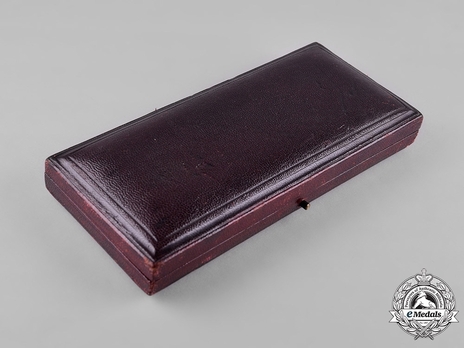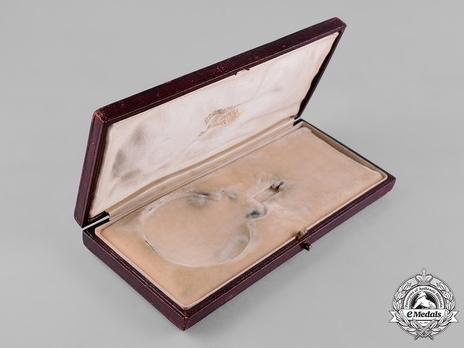The Most Eminent Order of the Indian Empire, Knights Commander Case
CATEGORY: Case of Issue
SKU: 01.GBR.0109.104.01.C.000
Estimated market value:


Estimated market value:
United Kingdom. A Most Eminent Order of the Indian Empire, Type I, Neck Badge Case
Instituted in 1878. Hardshelled design on both the lid and base with a deep maroon leather pebbled exterior on all sides, wooden-framed, the inside lid lined in white satin, padded and maker marked "R & S. GARRARD & Co. Goldsmiths & Jewellers TO THE CROWN 25 HAYMARKET LONDON" with a crown, the lining exhibiting the impression of the once present neck badge, a white fabric-wrapped cardboard insert placed within the base, the base lined in white rayon and supporting a raised platform in white felt with a recessed medal bed for the badge, dual-hinged, push release closure, measuring 73 mm (w) x 160 mm (h) x 27 mm (d), light wear evident on the exterior, light soiling on the white rayon base, the white felt on the raised platform soiled throughout, fine.
The Most Eminent Order of the Indian Empire was established by Queen Victoria, by the proposal of Lord Salisbury, in 1878. It was created in commemoration of her ascension as Empress of India and was considered a junior order to The Most Exalted Order of the Star of India. The Order has never been officially abolished, but no appointments have been made since India gained independence in 1947.
The Order was conferred upon Indian citizens for meritorious service to India and the British Empire. It was originally conferred in a single grade but was expanded to two grades in 1886, and to three grades in 1867. Foreigners could also be admitted to the Order, but only as honourary members.
When the Order was conferred in a single class, membership was unlimited. The membership limit was first changed when the Order was expanded in 1866 and has since been altered a number of times thereafter. In 1939, when the last amendments were made to the Order, membership was limited to 42 Knights Grand Commander, 150 Knights Commander, and an unlimited number of Companions. Members of the first and second classes were entitled to use the title “Sir.”
The original motto of the Order was “VICTORIA IMPERATRIX” (Empress Victoria), but it was changed to “IMPERATRICIS AUSPICIIS” (Under the Auspices of the Empress) in 1886.
There are two versions of the Commander that differ in inscription according to the official change to the motto of the Order.

Comments
Sign in to comment and reply.


Scroll Top